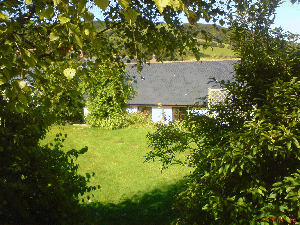 Free nature photos
Free nature photosGŵyl Ifan, the Festival of St. John the Baptist on June 24th, was the midsummer festival traditionally celebrated in Wales. It was one of the three ysprydnos or spirit nights when the world of the supernatural was closest to ours (the others being Nos Galan Gaeaf on 31st October and Nos Galan Mai, or Nos Galan Haf, on 30th April).
Three key elements of this calendar festival were: y fedwen haf, (the summer birch), the bonfire and the herb St John’s Wort.
Y fedwen haf
Reports of this custom come principally from Glamorgan although there are others from as far apart as Anglesey and Carmarthenshire. The birch was raised on the eve of St John’s Day and, according to one account by the blind poet, William Roberts, from the eighteenth century, the pole was adorned with colourful pictures and the young women decorated it with golden wreaths covered with ribbons. On the top was a weather-cock with gold feathers and ribbons on its tail and underneath that was a floating banner. Much dancing and merriment took place around the birch.

Y fedwen haf from the summer dance festival, Cardiff
see the Gŵyl Ifan website
There was a tradition of ‘the theft of the birch’, by which villagers from a neighbouring parish would try to steal the pole, so that the presence of strong youths was required to guard it. The theft of the birch had serious consequences because it was seen as a huge disgrace and no birch could be raised again until another had been stolen to replace it.
The bonfire
A bonfire was as central to the celebrations as it was at the festival of Calan Mai. Marie Trevelyan describes it vividly:
"Three or nine different kinds of wood and the charred faggots carefully preserved from the previous midsummer were necessary to build this fire, which was generally done on rising ground. Into this fire various herbs were thrown, and girls with bunches of three or nine different kinds of flowers would take the offered hands of boys who wore flowers in their buttonholes and hats, and jump together over the midsummer fire. Wild merrymakings these were, and the young people threw the flowers from their posies, hats, hair, and buttonholes into the heart of the flame. Roses and wreaths of various flowers were hung over the doors and windows on St John’s Eve and Day."
If anyone – human or animal – were to jump over the fire on St John’s Day, they were thought to be given immunity against fever and disease for a year.
Trefor M. Owen relates that the origin of these bonfires was in fires of actual bones (hence bone-fire) where the position of the bones after burning was used for divination purposes.
St John’s Wort
The plant known as St John’s Wort was widely revered in Celtic countries. In the Highlands and Islands of Scotland, it was spoken of in terms normally used for noble lords and chieftains as allail, 'of great renown', or loinneil, 'splendid', 'elegant'. The plant was thus honoured and while picking it the person would also recite the purpose it was required for and the intent in taking it, according to the Carmina Gadelica. In Wales it is known as dail y fendigaid or 'the blessed one’s leaf', and llys Ieuan, 'John’s herb'. As you can see from the picture above it is five-petalled, golden yellow with prominent stamens reminiscent of rays of the sun. The stamen, it should be noted, is the flower’s male reproductive organ which produces pollen.
St John’s Wort was put over the doors of houses to keep evil spirits away (mugwort was an alternative if it could not be found) and if gathered at noon on St John’s Day was considered to be effective against many illnesses.
Divination was practised as at the time of the other ysprydnos, since messages and influences could leak through from the Otherworld. Commonly, these divinations concerned the length of life and the likelihood of marriage. One way of divining the length of life using St John’s Wort, even as late as the middle of the nineteenth century, is given again by Marie Trevelyan:
"Take as many St John’s worts as there are people in the house. Clean these free of dust and fly, and hang them on the rafters of the room. Each wort was named after an individual. Those whose plants wither first, die first."
She also tells us that to forecast marriage, spinsters used to make a wreath or garland with nine different kinds of flowers. Then, while walking backwards, they would try to throw the garlands onto a tree. The number of times it fell to the ground represented the number of years they would remain unmarried.
Alexei Kondratiev states that in Brittany the place of the St John’s Wort was taken by the aour-yeotenn or ‘golden herb’ which shines like the sun in the dark on St John’s Eve and at no other time. Mysteriously, it could only be seen by those with the gift of seership. It is possible that this magical herb was actually the St John’s Wort seen in a symbolic or mystical way.
Bibliography
Trefor M. Owen, The Customs and Traditions of Wales. University of Wales Press, Cardiff, 1991.
Trefor M. Owen, Welsh Folk Customs. Gomer Press, Llandysul, 1987
Marie Trevelyan, Folk-lore and Folk-stories of Wales, EP Publishing Limited, Wakefield, 1973
Alexei Kondratiev, The Apple Branch. The Collins Press, Cork, 1998

